September 1921
Centre's school year, and therefore football practice, would begin on September 12. The Chief and Tiny Thornhill planned to arrive in Danville that very morning. Uncle Charlie hoped to arrive before the first game on October 1, if by then. It depended upon his umpiring duties as to when he could get to Danville.
The 1921 Press Day was as well attended as the 1920 event when the Colonels had drawn such interest after the undefeated 1919 season.
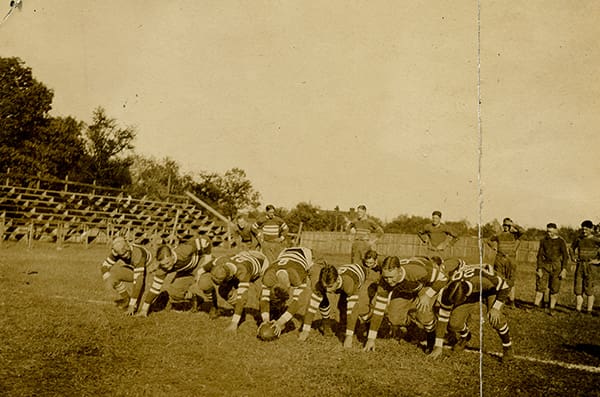
Press Day- 1921 Identifiable players are "Buck" Jones second from left with Ben Cregor ( 21 ) next to him. Ed Kubale ( 8 ) is centering the ball. Ray Class ( 20 ) is on the far right of the line in the left end position and Red Roberts is next to him in the left tackle position. The wooden stadium in the background stands in vivid contrast to the "castles" where members of the "Big 3" were playing as shown in Chapter 2.
The Colonels sported their new uniforms and poised with different lineups which included many of the new freshmen which were going to be so vital in the upcoming season.
Meanwhile, things were getting into motion as another campaign began in Cambridge.
Harvard began practice 3 weeks prior to a rather unusual opening doubleheader with Middlebury and Boston University. The Crimson planned to play both teams on the same day, September 24, and felt confident they had sufficient depth to perform double-duty against the two schools felt to be the "soft" part of their schedule.
They were correct about the depth. 87 men showed up for the first day of practice, and late arrivals boosted the total to 92 the next day. When 6 more players returned from a trip to the West, there were 98 varsity candidates.
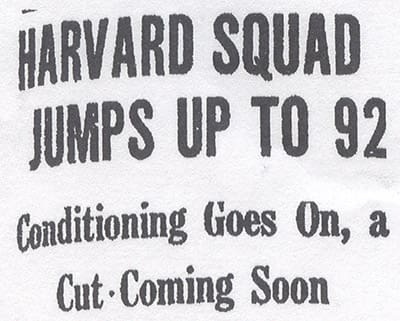
Article about the players available at Harvard in 1921 with a thinning of the squad eminent
These totals were only for the varsity team. The freshman team had 136 candidates competing for what would eventually be pared down to 34 slots. The breakdown of the first-year men was 34 trying out for end, 32 tackles, 14 guards, 6 centers, and 50 backs, of whom 20 were vying for a quarterback position.
Therefore, 234 young men were trying out for the freshman and varsity squads, just 28 less than the Centre's total enrollment of 262 in the fall of 1921.
Centre, under S.I.A.A rules, was allowed to play freshmen, and if this hadn't been the case, would have been hard pressed to field a team. There were only 137 sophomores, juniors and seniors on the Danville campus.
Harvard, in contrast, adhered to the custom in the East of allowing only 3 years of varsity play. While this may have seemed unfair at first glance, it actually gave the schools the advantage of turning their first-year men into better candidates for the varsity by more concentrated coaching and a regular schedule of games which gave them valuable experience going into their sophomore year.
Coach Fisher, in his third year at the helm, had a policy of hiring only former Harvard players as "active assistants" who had been on Harvard's varsity teams from his own time playing for the Crimson, 1909-1911, to the present.
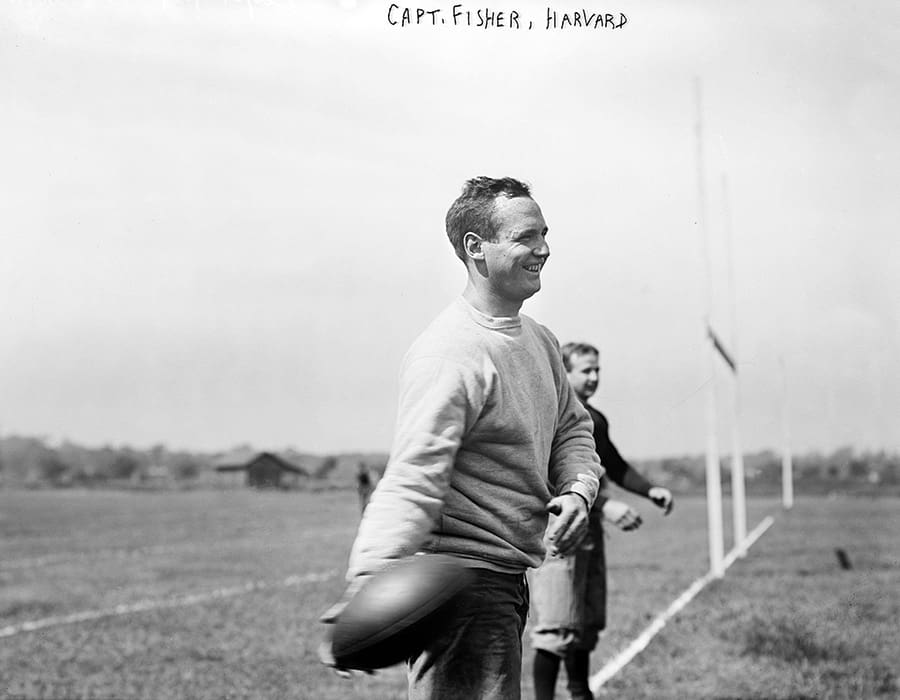
Robert Fisher, the Crimson team captain in 1911 during his senior year
This assured continuity in how the program was run. An "active assistant" position was in addition to what was termed a "daily coach."
Fisher wanted to better coordinate the coaching techniques of the freshman and varsity staffs. He hired a new freshman coach in 1921, Tommy Campbell, Harvard 1912, who had actually been the head coach at North Carolina.
Campbell was assigned four "active assistants" when he took over coaching the first-year men. Therefore, the freshman team had 5 coaches, 2 more than Centre's entire staff of Uncle Charlie, Chief Myers, and Tiny Thornhill. ( It was really a bit of a stretch to call Chief a coach. He was the Athletic Director, and helped with coaching when he could.)
Fisher retained 3 "active assistants" for the varsity. And then he had a "daily coach" for the centers, one for the guards, one for the tackles, and an end coach.
The Harvard varsity thus had 4 line coaches. Centre had Tiny Thornhill.
Harvard had a backfield coach, assisted by a coach who just worked with the quarterbacks. Eddie Mahan was also to work with the backs.
To cap off the coaching staff, there was a full-time coach in charge of the varsity's second team.
In summary, Harvard had 5 coaches for the freshmen, 11 for the varsity, and this didn't even include Coach Fisher, who rounded out the staff at a total of 17.
In addition, there were numerous student managers, assistant student managers, assistant trainers and locker room attendants, all overseen by the veteran head trainer, "Pooch" Donovan.
The Crimson had an abundance of skilled backs and excellent returning ends. They had lost the interior of their line from tackle to tackle, and the main concern of Coach Fisher and his staff was to rebuild that portion of the forward wall.
Harvard had a difficult schedule lined up. All of the games were scheduled for the big horseshoe except the Princeton contest, to be played at the Tigers' Palmer Stadium, a classic edifice built in 1914, the same year as the mammoth Yale Bowl.
Sept. 24 Boston University & Middlebury
Oct. 1 Holy Cross
Oct. 8 Indiana
Oct. 15 Georgia
Oct. 22 Penn State
Oct. 29 Centre
Nov. 5 Princeton
Nov. 12 Brown
Nov. 19 Yale
( The excellent "ESPN Football Encyclopedia" lists the game with Boston University as being played on September 17, but in fact, both BU and Middlebury were played on September 24.)
Harvard was coming off 2 great seasons, going 9-0-1 in 1919, including the Rose Bowl victory over Oregon, 7-6, and 8-0-1 in 1920. Both ties were with Princeton, 10-10 in 1919 and 14-14 the following year.
As practice began, despite the loss of key linemen, the Harvard coaches and team felt they could reload and continue in their winning ways.
Meanwhile, in Danville, the strongest freshman group which Centre had yet attracted was due to report in the fall of 1921. Certainly, the group that came in from Fort Worth in 1917 was impressive, but it was far fewer in numbers.
The 19 Centre freshmen in 1921 were from 9 states, and 7 had attended prep schools.
KENTUCKY
MAYFIELD
Herbert "Herb, Flash or Covey" Covington- 5'6" 150-Quarterback Mayfield High School
Castle Heights Military Academy, Lebanon, Tennessee
Clifton "Hennie" Lemon- 5'10" 165-End
Mayfield High School
LAWRENCEBURG
Ted "Tubby" Johnson- 6'1" 185-Guard
Lawrenceburg High School
LEXINGTON
Leslie "Les" Combs II- 5'11" 156-End Swarthmore Preparatory School- Swarthmore, Pennsylvania Morgan Park Military Academy-Chicago, Illinois
LOUISVILLE
Richard "Dick" Gibson- 6'1" 180-Tackle
Louisville Male High School
MILLERSBURG
Proctor "Proc" Wood- 5'8"-170-Center Millersburg Military Institute
NEWPORT
Robert L. "Case" Thomasson- 6’ 175-Fullback/End
Newport High School
SOMERSET
William "Bill or Shad" Shadoan- 6' 192-Guard
Somerset High School
ARKANSAS
FORT SMITH
Edwin "Kube" Kubale- 6' 175-Center
Fort Smith High School
ILLINOIS
JACKSONVILLE
Edwin "Alex" Alexander- 5'10" 163-Halfback Missouri Military Academy-Mexico, Missouri
LOUISIANA
ABBEVILLE
Minos "Cajun" Gordy- 5'10" 180-Tackle Peoples-Tucker Academy-Springfield, Tennessee
MICHIGAN
DETROIT
John "Johnny" Hunter- 5'8" 155-Halfback
San Diego High School, California ( Hunter's family moved to Detroit )
OHIO
MIDDLETOWN
Ray Class- 5'10" 169-Halfback
Middletown High School
PENNSYLVANIA
PITTSBURGH
Don Beane- 5'7" 175-Guard Peabody High School
TEXAS
AMARILLO
Howard "Bull" Lynch- 5'10" 180-Tackle
Amarillo High School
Hope Hudgins-5'7" 150-Halfback
Missouri Military Academy, Mexico, Missouri
DALLAS
George "Buck" Jones- 5'9" 213-Guard
Forrest High School
GATESVILLE
Frank "Rube" Rubarth- 5'11” 175-Guard
Gatesville High School
WISCONSIN
RACINE
Jack Rowland- 5'8" 150-Halfback
Tennessee Military Institute-Sweetwater, Tennessee
Centre's freshman class would add considerable strength to the Colonels during the 1921 season. Red Weaver, Sully Montgomery, Stanley Robb, and "Pap" Ford would be missed, but the newcomers arriving would more than make up for those not returning.
Centre received a blow shortly after classes began when Dr. Ganfield, the college president and great supporter of the school's athletic programs, announced that he was resigning and returning to Carroll College. Dr. Ganfield had received a doctorate of divinity from Carroll in 1912, and it had always been understood by those who were close to him that he wished someday to return to the Waukesha, Wisconsin college.
Dr. Ganfield made one vow when he announced that he was leaving. He had made it part of his contract with Carroll.
"I will not leave Danville and 'Old Centre' until after the Harvard game. I'll be on the sidelines."
Dr. Ganfield's resignation wasn't effective until after the 1921 football season ended
Meanwhile, up in Cambridge, things were clipping along. On September 14, Coach Fisher posted the names of 64 varsity men on a bulletin board in the locker room. There were 34 young men who read the list with disappointment.
Centre began the 1921-22 school year with "the highest enrollment it has ever had," according to accounts in the two local papers, even though actual numbers weren't supplied.
True enrollment figures for the college have always been a little difficult to determine in the era after the Great War. Totals like "the little college with less than 200 students," or, "last year there were 225 at the start of the year, and this fall, there appears to be more on campus," were reported throughout this period.
One way to calculate a total is to count the members of each class as they appear in the "Old Centre" yearbooks.
Centre Enrollment Fall 1921
In the 1922 yearbook, there were: 32 seniors
33 juniors
72 sophomores
125 freshmen
Total 262 from the 1922 yearbook "Old Centre"
That number was considerably higher than the preceding three years.
( 1918-19 ) 141 1919 "Old Centre"
( 1919-20) 183 1920 "Old Centre"
( 1920-21 ) 205 1921 "Old Centre"
Dr. Ganfield had felt that the exposure of Centre's athletic teams, particularly football, could boost the college's enrollment. His belief is borne out by the growth in the freshman class during the years when the Colonels began to attract big-time attention.
In 1918-19, there were 77, and by 1921-22, the freshman class had grown to 125, a bit over a 60% increase.
By comparison, the 1922 Harvard yearbook has photographs of 714 graduating seniors in the undergraduate school. According to a September 27, 1920, New York "Times" article, the total enrollment at Harvard was 6,000, approximately the population of Danville, Kentucky.
The Danville "Messenger" subscribed to the United Press news service and began to carry stories about anything that came across the wires regarding Harvard and its football team. Danvillians scoured every word, trying to divine how the Colonels and Crimson would stack up.
After the first week of practice in Cambridge, the "Messenger" notified its readers that: Line problems are the only football problems faced by Harvard as the Crimson gets ready for its biggest season in years.
Coach Fisher is frank in saying that much of the success of the Crimson team depends on the development of good linemen to replace the heavy forwards graduated last year.
The "Messenger" also reviewed the big intersectional games which were scheduled for the upcoming season
Centre vs. Harvard
Georgia Tech vs. Penn State
Indiana vs. Harvard
Georgia Tech vs. Rutgers
Georgia vs. Harvard
Tennessee vs. Dartmouth
By September 20, Centre was ready to scrimmage. Bo and Chick Murphy led one team while Army and freshman Herb Covington lead the other.
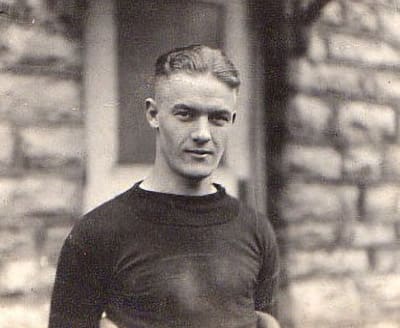
Army Armstrong, team captain 1921
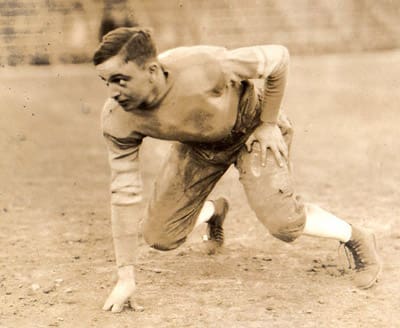
Joe "Chick" Murphy with the size 4 1/2 shoe
Covington was from Mayfield, Kentucky and came from a prominent family in the far-western Kentucky town.

Covington Brothers was a wholesale grocery company with operations in the Western Kentucky cities of Paducah, Mayfield, and Murray. Herb Covington's father, Gus Charles Covington ( 1862-1940 ), was a director and vice president of the company and attended the 1921 Centre-Harvard game with his wife, Georgia ( 1871-1960 ), and daughter, Lucy ( 1904-1994 ).
He was often called "Flash," because he could simply fly and was almost impossible to catch when he got open.
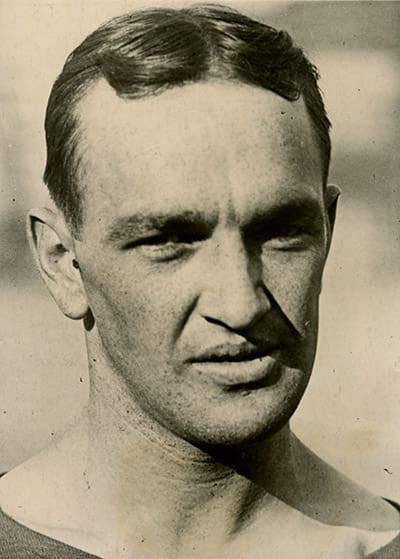
Freshman Herb "Flash" Covington from Mayfield, Ky.
"Covey" had a lot of confidence in his ability, confidence which was shown to be justified during his career as a Colonel.
When he arrived at Centre, he headed to the Danville City Barber Shop on Main Street for a touch-up prior to a fraternity rush party. While he was being trimmed, another patron asked him if was going to play football and he replied that he was, and he was a quarterback.
"Don't you know who the quarterback is? Bo McMillin holds down that position. And anyway, what makes you think you can play football?"
It was obvious that Covington's 5'6, 150 lb. frame didn't make him appear to be much of a threat on the gridiron.
Covington pulled a crisp $50.00 bill out of his pocket and said calmly, "I'll wager this with anyone who wants to bet that I won't earn my letter this year."
There were no takers. Had there been, Covey would have collected.
My father told me the following story about the City Barber Shop on Main Street when I went to Centre in 1959.
It was a black-owned and operated shop patronized by many of the townspeople and Centre students. The owner was a barber named Richardson who had gotten his name in a rather unusual way. His mother had a difficult labor, and when the newborn finally emerged, she was totally exhausted. The person who helped with the delivery needed to know what name to put on the birth certificate.
"Do you have a name for him?"
"No."
A couple of names were suggested.
"I don't care. Just name him either one."
On the wall at the City Barber Shop was a barber's license issued to Either One Richardson, always known as "Either O."
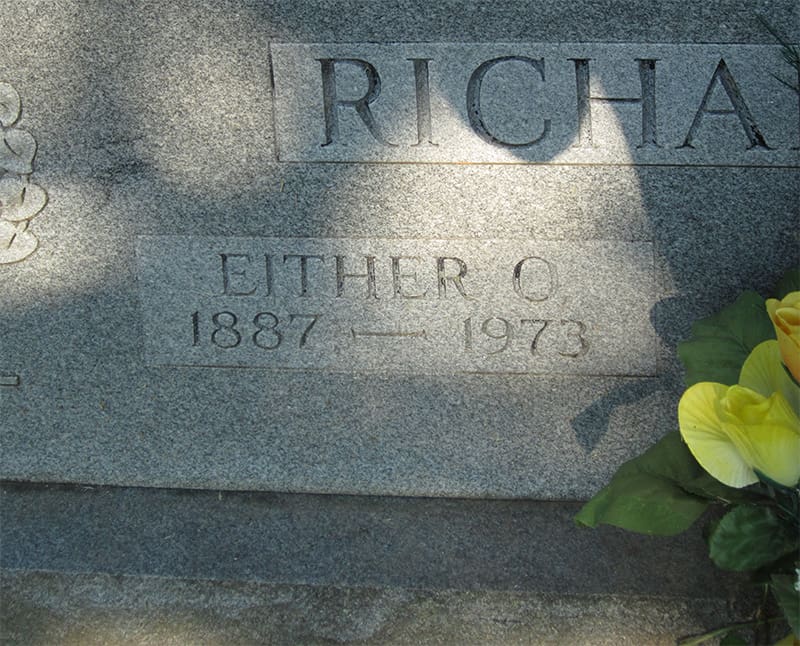
Either O.'s tombstone in Danville
Either One Richardson cut my father’s hair while he was at Centre from 1921-25 and my hair from 1959-63. He died in 1973 at age 86. He was quite a gentleman.
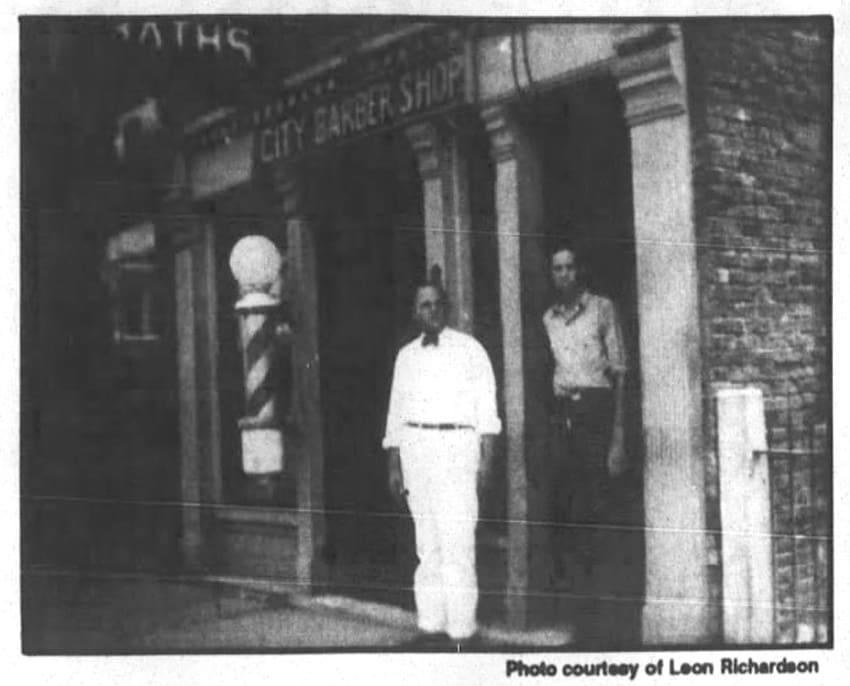
Either One Richardson in front of his Main Street, City Barber Shop, in downtown Danville with his son, Leon, on the right
It was apparent from the first that the freshmen were going to play a big role in the upcoming season. Ed Kubale took over Red Weaver's position at center, and even though it seemed impossible for anyone to outshine the 1919, All-American, it appeared Kube may just do that.
Herb Covington ran with skill and great speed. Minos Gordy, who had been recruited heavily by Vanderbilt, was a bull at the fullback position and a hard-hitting tackle when moved into the line.
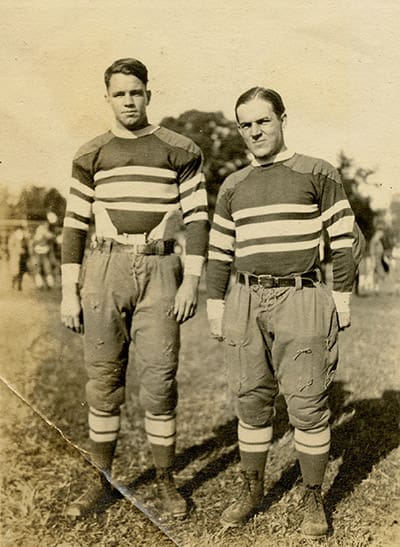
Minos Gordy, left, with Hump Tanner who both could fill the fullback position
It was obvious that Bill Shadoan was going to measure up to what Eddie Mahan had said about the Somerset native, and freshman George "Buck" Jones from Dallas looked like he would earn a starting position in the line.

George "Buck" Jones
On September 24, the veterans and freshmen went at it in a full-fledged scrimmage. Several hundred fans paid a quarter to watch. The papers had said that it should be a very evenly balanced game, but they were wrong.
Bo stood out and the vets showed the new men what Centre football was all about, racking up a 38-0 win.
Hump crashed through for 2 scores. Tom Bartlett hit Terry Snowday for a score and then Bo hit Bartlett for a TD. Chick Murphy broke loose on an end-around and put 6 on the board on a nice bit of broken field running.
Bartlett kicked 5 extra points and Red Roberts, who played both in the line and backfield, booted a 35-yard field goal.
The "Messenger" summarized the game.
Bo worked in his usual scintillating form and appears even faster than he was last year. The spirit and general morale evidenced Saturday afternoon convinced followers that the team was returning to the level of the 1919 championship squad.
( Remember that bold face indicates a story or recollection by Robert W. "Red" Robertson, M.D. who was at Centre from 1921-25.)
I enrolled at Centre in September of 1921. I was 17 and didn't turn 18 until December.
I went to the game between the varsity and freshmen. Of course, I was sort of pulling for the freshmen because a lot of them lived in Breckinridge Hall where I roomed. By the way, my room was 314 and I had some influence later when my son Rob, Jr. enrolled in 1959 and he was assigned the same room his freshman year.
What I remember most about the game was that I've never seen such hitting. At our high school in Elizabethtown, it seemed like most of the time, tackles were made by just grabbing someone and flinging them to the ground.
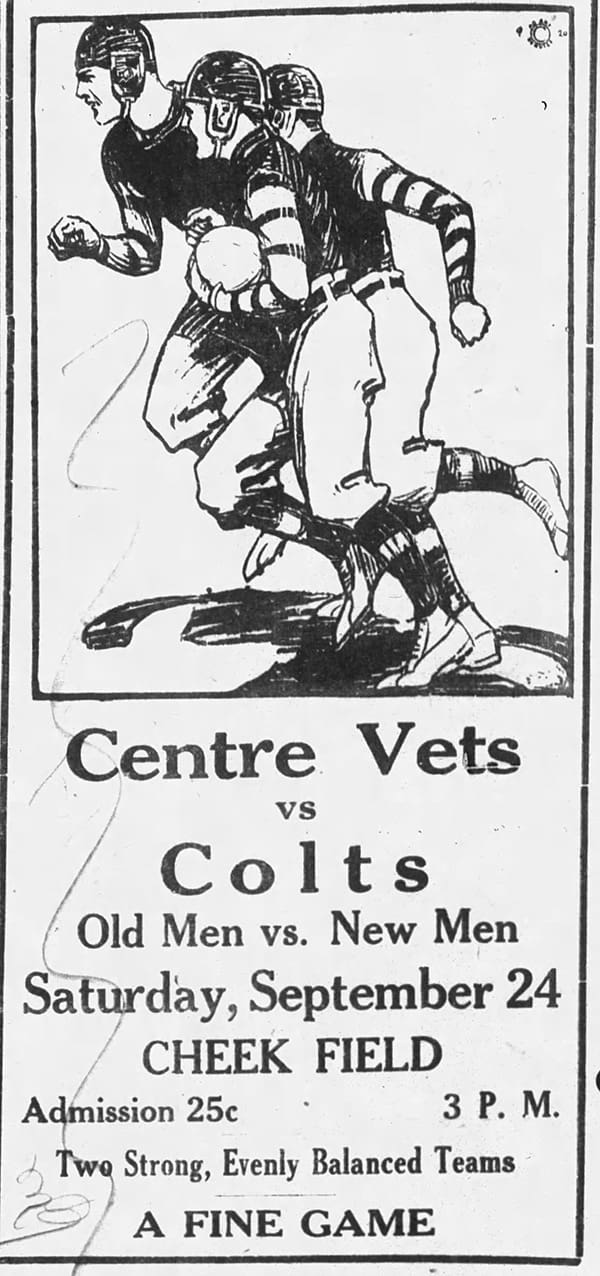
Notice regarding upcoming game
I saved the ticket to the game and still have it after all of these years. I guess I saved it because it was the first time I'd ever seen Centre's team in action, even if it was an exhibition between the varsity and freshmen.

Ticket which Red Robertson saved for decades
People remember Bo because of his passing and running, but he was like all of the rest of the team. When Bo hit somebody, they knew they'd been hit. He loved contact, just like all of the guys did.
Red Roberts did, too. He'd take on anyone, and I never saw him wear a helmet.
Everyone used to talk about the great offensive teams that Centre had, and we indeed did have a wonderful offense.
But Centre played a ferocious defense.
Speaking of Red and Bo, something happened that September when I enrolled which it took me years to talk about but when I think back on it now, I guess it is a story which I feel OK telling.
I mentioned earlier that way back when Howard and I had been visiting Danville when I was still in high school in Elizabethtown, I'd been introduced to Red Roberts and he'd taken some interest in me because of being Red Robertson and becoming known as Red Roberts' "son."
One night several of the guys including Red were in the lounge at Breck Hall and when I walked in, they began to kind of smile and laugh and I didn't really understand what was going on. I was just a 17 year-old-freshman and was intimated in a big way just by being in the room with a group of guys I considered real heroes.
They sort of whispered back and forth and one of them said, "Red Roberts' son, we've got a surprise for you. Glad you decided to join us."
I still didn't know what was going on but soon found out.
It seemed that from time to time, there were a group of "ladies of the night" who traveled on the Southern Railroad going from college to college and providing "services" to anyone willing to pay for a "favor."
Tonight, they were in Danville and that's why the guys were in the lounge at Breck, waiting for their turn.
And, they decided they were going to buy me a "favor" which nearly scared me to death. I'd never even kissed a girl and actually "doing it" with one was something I couldn't even begin to imagine.
But they began saying things like, "No son of Red Roberts is going to ever going to turn down a free "favor." They began to kid me mercilessly and the more they kidded me, I realized that there was no way I was getting out of that room without "doing it."
However, I thought maybe I could escape by telling them that I'd heard about getting some disease and told them I'd been warned about a guy in Elizabethtown going crazy after getting syphilis and they said not to worry, they had me covered.
So I was trapped, but then I guess my 17-year-old hormones kicked in and I decided maybe this wasn't the end of the world but could be something that may be every guy's dream and I should take advantage of it.
After one of the guys came back in the lounge, he told the next fellow in line to tell whichever girl he was going to be with in the yard behind Breck Hall there was a freshman named Red Robertson and he was going to be next.
When I said again that I was worried about getting syphilis, I was given 3 lambskins which were what were used in those days for protection and told there was no way I was going to catch anything with triple "skins."
So, I headed behind Breck when it was my turn and there was this young "lady of the night" lying on her back with her skirt pulled up and her legs sort of spread. There was a full moon shining down on her and I have to admit it was the most exciting thing I'd ever seen.
So I grabbed my "skins" and pulled down my pants and I was ready. I slipped on the first "skin" and then slid on the second one and the motion of putting on the third one was simply too much and it was all over. I guess she realized what had happened and she said, "Well, that was the easiest couple of bucks I've ever made" and begin to laugh.
There was nothing to do but pull up my pants and toss the money toward her I'd been given and get out of there. When I got back to the side of Breck, I decided to wait a couple of minutes because I wanted it to seem like something had happened while I was behind the dorm. Then I went back in the lounge and the guys asked me how it had been.
I remember going on and on about how wonderful it had been and it was like nothing I'd ever experienced and then they all begin to laugh.
"Red, you little liar. We were watching out of the dorm window where we could watch and you never even touched her! I think we need our money back!"
It was probably one of my most embarrassing moments I've ever experienced.
But, you know, it was really good in a way. The guys seemed really fond of me after my experience with a "lady of the night." Sure, for a while, they'd call me "Quick Shot" when they saw me on campus, but Red told them not to embarrass his son and I became much better known after that night and players who would never have recognized some freshman like me would greet me on campus which really thrilled me, and made me feel sort of like a little special.
I guess you could say I lost my virginity behind Breck Hall that night, but in a most unconventional way!
__________________________________________________________________________________
While Centre was having an intra-squad game, Harvard was putting on the doubleheader with Boston University and Middlebury before a decent, but nowhere near, capacity crowd.
The Crimson played over 50 men in the two contests. The starters were in the line-up at the beginning of the Boston U. game, but one of the reasons that the two games had been paired on the same Saturday was to give the Harvard coaches plenty of opportunity to evaluate their personnel in game conditions.
Substitutions were frequent. The Crimson beat Boston U. 10-0, and then Middlebury went down 16-0. Little Middlebury fought to the end, and the crowd cheered them on near the end of the contest when Harvard had first and goal on the Panthers' 5-yard line, and the boys from Vermont stopped four straight rushes and regained possession.
Winnie Churchill, the same Churchill who had tackled Bo just short of the goal line during Centre's first scoring drive in 1920, scored both of the TD's against Middlebury.
During Christmas vacation the previous year, he had visited a friend in Louisville and said he couldn't be so close to Danville and not come see the school. His friend drove him down on the several hour trip, and when it was discovered who he was, the "Messenger" reported:
A crowd of men and boys followed the great gridiron star as though he was a conquering hero from the field of battle. Churchill walked over to Cheek Field and tore a large splinter off the stands and carried back a bag of soil from the field.

( The top of the north side stands with a deficit which could possibly have been where Winnie Churchill ripped "a large splinter off the stands" to return to Cambridge as a souvenir. Young Hall is just to the left in the background. )
He said the people of Boston were electrified by the wonderful play of the Centre team and were delighted with the sportsmanship of the players and the entire Centre delegation, and that the Crimson team was highly pleased that they were going to play Centre again in the Stadium in the fall.
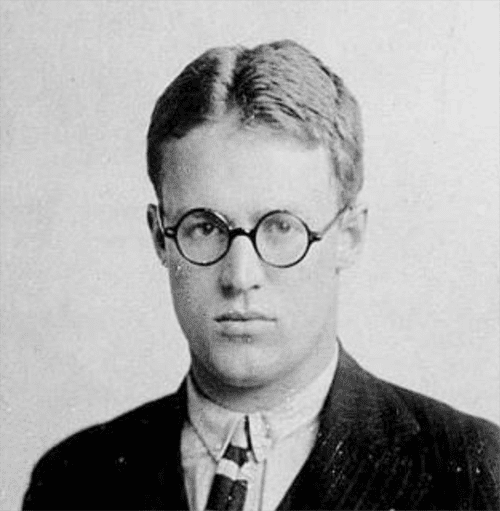
Winnie Churchill
( Winthrop Hallowell Churchill- 1900-1960- originally from Chicago, prepped at Milton Academy in Massachusetts and was a member of the class of 1923. He had a long career in banking, being a director of both the Fiduciary Trust of Boston, Cambridge Bank and Trust, and a trustee of the Cambridge Savings Bank. His father, Frank Spooner Churchill, MD, was a Harvard Medical School graduate and a noted pediatrician in Chicago. His mother was Lucretia Mott Hallowell Churchill, the granddaughter of abolitionist Lucretia Mott. )
